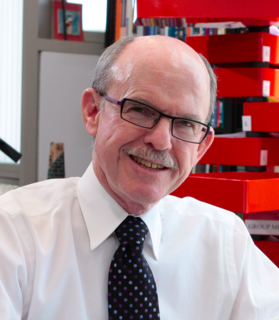
Kendall Newcomb Houk is a Distinguished Research Professor in Organic Chemistry at the University of California, Los Angeles. His research group studies organic, organometallic, and biological reactions using the tools of computational chemistry. This work involves quantum mechanical calculations, often with density functional theory, and molecular dynamics, either quantum dynamics for small systems or force fields such as AMBER, for solution and protein simulations.
Tobin Jay Marks is the Vladimir N. Ipatieff Professor of Catalytic Chemistry, Professor of Material Science and Engineering, Professor of Chemical and Biological Engineering, and Professor of Applied Physics at Northwestern University in Evanston, Illinois. Among the themes of his research are synthetic organo-f-element and early-transition metal organometallic chemistry, polymer chemistry, materials chemistry, homogeneous and heterogeneous catalysis, molecule-based photonic materials, superconductivity, metal-organic chemical vapor deposition, and biological aspects of transition metal chemistry.
Robert George Bergman is an American chemist. He is Professor of the Graduate School and Gerald E. K. Branch Distinguished Professor Emeritus at the University of California, Berkeley.

Krzysztof "Kris" Matyjaszewski is a Polish-American chemist. He is the J.C. Warner Professor of the Natural Sciences at the Carnegie Mellon University Matyjaszewski is best known for the discovery of atom transfer radical polymerization (ATRP), a novel method of polymer synthesis that has revolutionized the way macromolecules are made.

Jeehiun Katherine Lee is an organic chemist and a Professor in the Department of Chemistry at Rutgers University. She currently runs a research lab on the New Brunswick campus.
Jing Li is a professor at Rutgers University. She and her team are engaged in solid state, inorganic and inorganic-organic hybrid materials research. Her current research focuses on designing and developing new materials for applications in the field of renewable and sustainable energy.
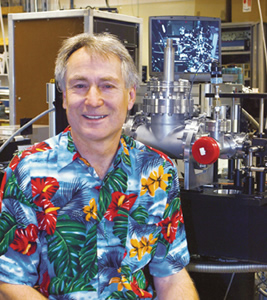
Richard J. Saykally is an American chemist. He is currently the Class of 1932 Endowed Professor of Chemistry at the University of California, Berkeley. He has received numerous awards for his research on the molecular characteristics of water and aqueous solutions.
The Dreyfus Prize in the Chemical Sciences is an award given to an individual researcher in chemistry. The prize, awarded biennially, consists of a citation, a medal, and a monetary award of $250,000. The prize is awarded by The Camille and Henry Dreyfus Foundation, Inc. to an individual in a selected area of chemistry "to recognize exceptional and original research that has advanced the field in a major way."
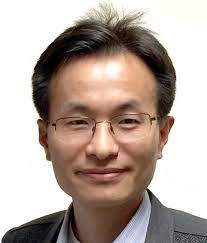
Peidong Yang is a Chinese-American chemist, material scientist, and businessman. He is currently a professor at the University of California, Berkeley and a member of the American Academy of Arts and Sciences. He is a Professor of Chemistry and a Professor of Materials Science. His research group studies the synthesis of nanomaterials and their electronic and optical properties. He is also a Department Head at the Joint Center for Artificial Photosynthesis, Senior Faculty Scientist at Lawrence Berkeley National Laboratory, and Deputy Director of the Center of Integrated Nanomechanical Systems (COINS). He is an associate editor of the Journal of the American Chemical Society, an American Chemical Society Journal.

Marsha Isack Lester is an American physical chemist. She is currently the Edmund J. Kahn Distinguished Professor of Chemistry at the University of Pennsylvania. Lester uses both theoretical and experimental methods to study the physical chemistry of volatile organic compounds present in the earth's atmosphere. Her current work focuses on the hydroxyl radical and Criegee intermediates.

Camille Edouard Dreyfus was a Swiss chemist. He and his brother Henri Dreyfus invented Celanese, an acetate yarn. He founded The Camille and Henry Dreyfus Foundation in honour of his brother.
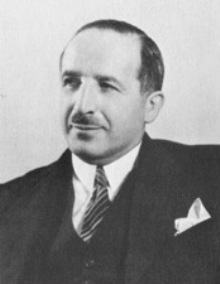
Henri Dreyfus was a Swiss inventor of the modern weaving loom. He and his brother Camille Dreyfus also invented Celanese, an acetate yarn.
Gustavo E. Scuseria is the Robert A. Welch Professor of Chemistry, Professor of Physics & Astronomy and Professor of Materials Science & NanoEngineering at Rice University, Houston, TX. He is also editor-in-chief of the Journal of Chemical Theory and Computation. Scuseria earned his PhD from the University of Buenos Aires in 1983 and conducted post-doctoral work at the University of California, Berkeley (1985-1987) and the University of Georgia (1987-1989) prior to joining the chemistry faculty at Rice University in 1989.
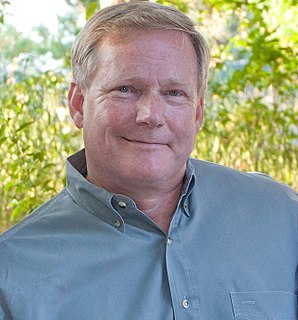
John L. Wood is a Robert A. Welch Distinguished Professor of Chemistry and Biochemistry; Cancer Prevention Research Institute of Texas Scholar; and Associate Editor for the Americas, Tetrahedron Letters at Baylor University.

Lucio Frydman is an Israeli chemist whose research focuses on magnetic resonance imaging (MRI), nuclear magnetic resonance (NMR) and solid-state NMR. He was awarded the 2000 Günther Laukien Prize, the 2013 Russell Varian Prize and the 2021 Ernst Prize. He is Professor and Head of the Department of Chemical and Biological Physics at the Weizmann Institute of Science in Israel and Chief Scientist in Chemistry and Biology at the US National High Magnetic Field Laboratory in Tallahassee, Florida. He is a fellow of the International Society of Magnetic Resonance and of the International Society of Magnetic Resonance in Medicine. He was the Editor-in-Chief of the Journal of Magnetic Resonance (2011-2021).

Gregory A. Voth is a theoretical chemist and Haig P. Papazian Distinguished Service Professor of Chemistry at the University of Chicago. He is also a Professor of the James Franck Institute and the Institute for Biophysical Dynamics.

Brandi Michelle Cossairt is an American chemist specializing in synthetic inorganic and materials chemistry. She is an Associate Professor of Chemistry at University of Washington.
Julia Ann Kalow is an Assistant Professor of Chemistry at Northwestern University. She is primarily a synthetic chemist, who works on polymers, photochemistry and tissue engineering. She is interested in synthetic strategies that can turn molecular structure and chemical reactivity into macroscopic properties. She has been awarded the National Science Foundation CAREER Award, Thieme Award and was selected by the University of Chicago as a Rising Star in Chemistry.
Steven D'Wayne Townsend is a Professor of Organic Chemistry at Vanderbilt University. He investigates the chemistry of human breast milk. In 2019 Townsend was selected as one of Chemical & Engineering News Talented 12.
Munira Khalil is an American chemist who is the Leon C. Johnson Professor of Chemistry and Department Chair at the University of Washington.











